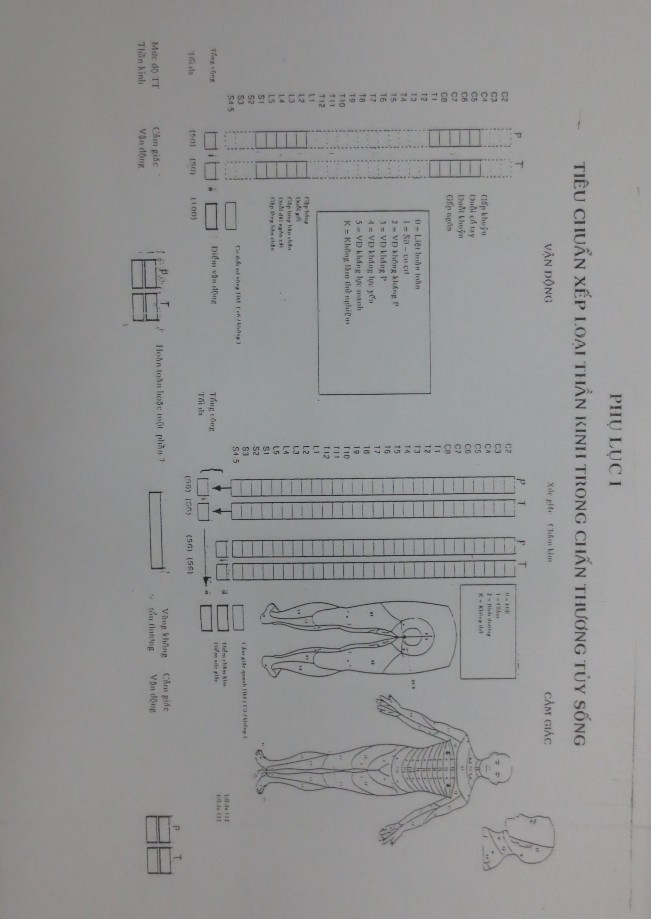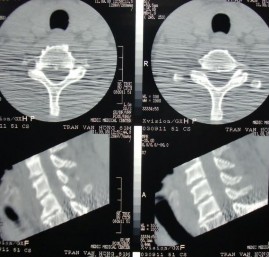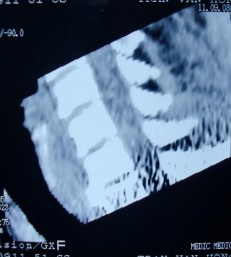36.Benzel E.C and Kesterson L. (1989), "Posterior cervical interspinous compression wiring and fusion for mid to low cervical spine injuries". J . Neurosurgery. 70, pp. 893-899.
37.Berry J. L., Morgan J. M. and Berg W. S. (1987), "A morphometric study of human lumbar and selected thoracic vertebrae". Spine. (12), pp. 362-366.
38.Bohlman H (1999), "Spine and spinal cord injuries". The spine. (33), pp. 908. 39.Bohlman H and Abdu W.A. (1992), "Techniques of subaxial posterior cervical
spine fusions: An overview". Orthopedics. 15, pp. 287-295.
40.Bohlman H (1978), "Complication of treatment of fractures and dislocations of cervical spine". Complication in orthopaedic surgery. Vol.II,, pp. 611- 640.
41.Bohlman H (1979), "Acute fractures and dislocations of cervical spine". J.B.J.S. (61A), pp. 1119-1142.
42.Bohlman H (1985), "The triple wire fixation technique for stabilization of acute cervical fracture-dislocations: A biomechanical analysis". JBJS, Orthopaedic transactions. 9, pp. 142.
43.Braakman R. and Penning L. (1968), "The hyperflexion sprain of the cervical spine". Radio. Clin. Biol. (37), pp. 309.
44.Bracken M.B. (1984), "Efficacy of methylprednisolone in acute spinal cord injury". JAMA. (215), pp. 45-51.
Có thể bạn quan tâm!
-
 Diễn Biến Phục Hồi Thần Kinh Chi Trên Ở Lần Khám Cuối Cùng.
Diễn Biến Phục Hồi Thần Kinh Chi Trên Ở Lần Khám Cuối Cùng. -
 Thời Gian Mổ (Tính Từ Lúc Rạch Da Đến Khâu Da Xong).
Thời Gian Mổ (Tính Từ Lúc Rạch Da Đến Khâu Da Xong). -
 Xác Định Cỡ Chỉ Thép Phù Hợp Csc Thấp, Độ Vững Của Phẫu Thuật Bohlman Cải Tiến.
Xác Định Cỡ Chỉ Thép Phù Hợp Csc Thấp, Độ Vững Của Phẫu Thuật Bohlman Cải Tiến. -
 Điều trị chấn thương cột sống thấp cơ chế cúi - căng - xoay bằng phẫu thuật Bohlman cải tiến - 22
Điều trị chấn thương cột sống thấp cơ chế cúi - căng - xoay bằng phẫu thuật Bohlman cải tiến - 22 -
 Điều trị chấn thương cột sống thấp cơ chế cúi - căng - xoay bằng phẫu thuật Bohlman cải tiến - 23
Điều trị chấn thương cột sống thấp cơ chế cúi - căng - xoay bằng phẫu thuật Bohlman cải tiến - 23 -
 Điều trị chấn thương cột sống thấp cơ chế cúi - căng - xoay bằng phẫu thuật Bohlman cải tiến - 24
Điều trị chấn thương cột sống thấp cơ chế cúi - căng - xoay bằng phẫu thuật Bohlman cải tiến - 24
Xem toàn bộ 201 trang tài liệu này.
45.Bradford D.S (1987), "Surgical management of thoracolumbar spine fractures with incomplete neurologic deficits". Clinical Orthopaedics. 218, pp. 201- 216.
46.Branch C. L. Jr. et al (1989), "Fixation of the cervical spine using methylmethacrylate and wire: Technique and results in 99 patients". Neurosurgery. (4), pp. 503-513.
47.Bridwell K. H (1995), "Anterior fresh frozen structural allografts in the thoracic and lumbar spine ". Spine. 20(12), pp. 1410-1418.
48.Bucholz R.D (1989), "Holo - vest versus spinal fusion for cervical injury: Evidence from outcome study". J. neurosurgery 70, pp. 884 - 892.
49.Bucholz W. R (1992), "Lower cervical spine injuries", Skeletal trauma. 1, pp.
699-727.
50.Callahan R. A (1977), "Cervical facet fusion for control of instability following laminectomy". JBJS. 59, pp. 991.
51.Cloward..R. B. (1961), "Treatment of acute fractures and fracture dislocations of the cervical spine by vertebral-body fusion. A report of eleven cases". Neurosurg. (18), pp. 201-209.
52.Cone W. and Turner. W. G (1937), "Treatment of fracture dislocation of cervical spine by skeletal traction and spinal fusion". J.B.J.S. 19, pp. 584 -585.
53.Craig A. B (1991), "Unilateral facet dislocations and fracture-dislocations of the cervical spine". JBJS. 73-B, pp. 977-981.
54.Daffner R.H (1992), "Evaluation of cervical vertebral injuries". Semin Roentgrnol. 27, pp. 239 - 253.
55.Daniel R.. R (1991), "Series of ninety - two traumatic cervical spine injuries stabilized with anterior ASIF Plate fusion technique". Spine. (16), pp. 46-55.
56.Darsaut T.E (2006), "A pilot study of magnetic resonance imaging-guided closed reduction of cervical spine fractures". Spine. 31, pp. 2085-2090.
57.Davey J.R. (1985), "A technique of posterior cervical fussion for instability of cervical spine". Spine. pp. 722 -728.
58.Delamarter B. R (1995), "Pathophysiology of spinal cord injury recovery after immediate and delayed decompression". JBJS. 77( A), pp. 1042-1049.
59.Denis F. (1983), "The three-column and its significance in the classification of acute thoracolumbar spine injuries". Spine. (8), pp. 817-831.
60.Ducker B. T (1978), "Experimental spinal cord trauma, III; Therapeutic effect of immobilization and pharmacologic agents". Surg. Neurology. pp. 71-76.
61.DvorakM.F (2007), "The surgical approach to subaxial cervical spine", Spine.
32, pp. 2620-2629.
62.Edward N. H (1992), "Operative of spinal injuries surgical management".
Skeleton trauma. (1), pp. 645-661.
63.Elizabeth M. Y (2010), "Management of cervical facet dislocation: Anterior versus posterior approach", Controversies in spine surgery. Best evidence recommendations. Thieme Medical Publishers. pp. 48-57.
64.Frankel H L. (1978), "The value of postural reduction in the initial management of closed injuries of the spine with paraplegia and tetraplegia". Paraplegia. 7, pp. 179-192.
65.Freeman L. B (1987), "Fractures, dislocations, and fracture - dislocations of spine", Campbell’s operative orthopaedics. 4, pp. 3109-3138.
66.George W. W (2008), "Fractures, Dislocations, and Fracture-Dislocations of the Spine", Campbell's operative orthopaedics. Two, pp. 1761-1835.
67.Gleisser F H (1991), "Recovery of motor function after spinal cord injury, a randomized, placebo controlled trial with GW1 Ganglioside". New England J.Med. (324), pp. 1829-1839.
68.Gordon J. P (1964), "Flexion injuries of the cervical spine". The journal of bone and joint surgery. pp. 1800-1806.
69.Gordont T. W (1965), "Analysis of wounds involving the cervical canal incurred in the Korean war". Neurological surgery of trauma. pp. 327-332.
70.Guttmann L. (1976), "Spinal cord injuries". Black well scientific publication. pp.
9-25.
71.Hadra B.E. (1975), "Wiring of The vertebra as a means of immobilization in fracture and pott’s disease". Clin Orthopaedics. (112), pp. 4-8.
72.Hardley M.N (1992), "Facet fracture - dislocation injuries of the cervical spine".
J. neurosurgery. 30, pp. 661-666.
73.Holdsworth F. W. (1970), "Fractures, dislocations and fracture dislocations of the spine". J.B.J.S. 52A, pp. 1534-1551.
74.Huelke D. F. and Nusholtz G. S. (1986), "Cervical spine biomechanics. A review of the literature". J Orthopaedics Res (4), pp. 232.
75.Jeanneret B. (1991), "Posterior stabilization of the cervical spine with hook plates". The Spine. 16(3), pp. 56-64.
76.Jenkin D. H R. (1981), "Cervical spine". Manual of spinal surgery. pp. 1-8. 77.Jeremy W. Y (1998), "Radiologic evaluation of the spine injurred patient", Spine
trauma. pp. 28-60.
78.Joseph S. Torg (1989), "Risk factors in congenital stenosis of the cervical spinal canal", The cervical spine. Lippincott. pp. 272-284.
79.Kelly R. P. and Whitesides T. E. (1968), "Treatment of lumbodorsal fracture dislocation". Ann Surg. (167), pp. 705-717.
80.Larsson S. E (1994), "Chronic pain after soft-tissue injury of the cervical spine: Trapezius muscle blood flow and electromyography at static loads and fatigue". Pain. 57(2), pp. 173-180.
81.Leventhal R. M (1998), "Fractures- dislocations and fractures- dislocations of spine". Campbell’s operative orthopaedics. pp. 2704- 2746.
82.Lohrens P (1989), "Physiology and Biomechanics; Functional anatomy of Joints and Disc", The cervical spine. 2, pp. 33-56.
83.Louis R. (1985), "Spinal stability as defined by the three-column spine concept".
Anat Clin. (7), pp. 33-42.
84.Margaret E.C (1992), "Standardization of the Visual Analogue Scale (VAS)".
Nursing research, 41(6), pp. 378-379.
85.Mc Afee P. C. and Farey I. D. (1989), "Device-related osteoporosis with spinal instrumentation". Spine. (14), pp. 919-926.
86.Mc Afee P. C. and H.H. Bohlman (1995), "One stage anterior cervical decompression and posterior stabilization". J.B.J.S. 77-A((12)), pp. 1791- 1799.
87.Murphy M. J and Southwick (1999), "Surgical approach to the spine". The Spine. (2), pp. 1530-1531.
88.Myklebust J. B., Pintar F. and Yoganandan N. (1988), "Tensile strength of spinal ligaments". Spine. (13), pp. 526-531.
89.Naito M., Kurose S. and Oyama M. (1993), "Anterior cervical fusion with the Caspar instrumentation system". International orthopaedics, SICOT. pp. 73- 76.
90.Nielsen F.C (1991), "Posterior wiring without bony fusion in traumatic distractive flexion injuries of the mid to lower cervical spine". The Spine 16(4), pp. 467- 472.
91.Norton W. (1962), "Fractures and Dislocations of the Cervical Spine". JBJS. (44A), pp. 115-139.
92.Omar M and Mathur M. S (1995), "Modified technique of tension band wiring inflexion injuries of the middle and lower cervical spine". Spine. 20 (11), pp. 1224 -1244.
93.Panjabi M. M and White A. A (1990), "Clinical biomechanics of the spine".
Clinical orthopaedics (J.B.Lippincott Comp), pp. 1-125.
94.Panjabi M. M., Duranceau J. and Coel V. (1991), "Cervical human vertebrae: Quantitative three dimension anatomy of the middle and lower region". Spine. (16), pp. 861-869.
95.Pavlov H and Torg J.S (1987), "Cervical stenosis determination with vertebrae body ratio method". Radiology. (164), pp. 771-775.
96.Pelker R. R, Joanne S. D and Panjabi M. M (1991), "A three dimentional, Biomechanical evaluation of rotational stability, Strength and failure mechanisms". Spine. 16(2), pp. 117-122.
97.Penning L. and Wilmink J. T. (1987), "Rotation in the cervical spine. A CT study in normal subjects". Spine. (12), pp. 732-738.
98.Piazza R. M (1991), "Complication in cervical spine injury". Complication in spinal surgery, pp. 111-112.
99.Renn O. H (1984), "Posterior stabilization with an interlaminar clamp in cervical injuries: technical note and review of the long term exprience with the method". Neurosurgery 14 (3), pp. 318-322.
100.Robert R. C, Thomas E and Augustus A. W (1989), "Mechanism of injury in the cervical spine: Experimental Evidence and Biomechanical Modeling". The Cervical Spine. (2), pp. 70-87.
101.Robinson R. A and Southwick W. O (1960), "Indications and technique for early stabilization of the neck in some fracture dislocations of the cervical spine". South, Med. J. 53, pp. 565.
102.Roger W. A. (1942), "Treatment of fracture - Dislocation of the cervical spine".
JBJS. 24A, pp. 250 -256.
103.Roger W. A. (1957), "Fracture and dislocations of the cervical spine. An end result study". JBJS 39A, pp. 341-376.
104.Sawin P. D. (1998), "Techniques of posterior subaxial cervical fusion". Tech Neurosurg. (1), pp. 71-83.
105.Schneider R. C (1956), "Chronic neurological sequelae of acute trauma of the spine and spinal cord. (part I) The significance of the acute flexion or “tear- drop” fracture - dislocation of the cervical spine". J.B.J.S. 38A, pp. 985 - 997.
106.Segal D. (1981), "Tension band fixation of acute cervical spine fracture".
Clinical orthopaedics. 159, pp. 211-222.
107.Southwick W. O. (1964), "Normal cervical spine". JBJS. (8), pp. 1767 -1781. 108.Stauffer E. S (1986), "Management of spine fractures C3 to C7". Orthopaedic
clinics of north America. 117(1), pp. 45-53
109.Stauffer E. S (1991), "Fractures and Dislocations of the cervical spine",
Fractures in adults. 2, pp. 1340-1342.
110.Stauffer E. S (1989), "Rehabilitation of Posttraumatic cervical spinal cord quadriplegia and pentaplegia", The Cervical spine. 2. pp. 521-525.
111.Stauffer E. S and Kell G. A (1977), "Fracture-dislocations of the cervical spine. Instability and recurrent deformity following treatment by anterior interbody fusion". JBJS. 1A, pp. 45.
112.Stauffer E. S and Michael M. M. (1996), "Fractures and dislocations of the cervical spine", Fractures in adults. pp. 1473-1525.
113.Timothy A. M. et al (2006), "Classification of lower cervical spine injuries".
Spine. 31(11 suppl), pp. S37-S43.
114.Tod J. A (1999), "Spine instrumentation". The Spine. 2, pp. 1461-1657. 115.TribusC.B (1994), "Controversies and perils: cervical disk herniation in
association with traumatic facet dislocation". Tech Orthop. 9, pp. 5 - 7 116.Vaccaro R. A. (2007), "The sub-axial cervical spine injury classification system
(SLIC): A novel approach to recognize the importance of morphology, neurology, and integrity of the disco-ligamentous complex". Spine. 32(21), pp. 236-574.
117.Weir C. D (1975), "Roentgenographic signs of cervical injury". Clinical orthopaedics and related research (109), pp. 9-17.
118.White A. A., Panjabi M. M. and Brand R. A. (1975), "A system for defining position and motion of human body parts". J Fed Med Biol Eng. pp. 261.
119.Whitehill R., Stowers S. F. and Fechner R. E. (1987), "Posterior cervical fusion using cerclage wire, methylmethacrylate cement and autogenous bone graft and experimentalstudy of a canine model". Spine. (12), pp. 12-22.
120.Whitesides E. T (1977), "Traumatic kyphosis of the thoracolumbar spine".
Clinical Orthopaedics and related research(128), pp. 78-79.
TIẾNG PHÁP
121.Argenson C. (1993), "Traumatisme du rachis cervical". Imprimé par sur EMC - CONSULTE le lundi 23 février 2004. pp. 1-68.
122.Argenson C. (1994), "Traumatismes du rachis cervical inférieur". Conférences d’enseignement De S.O.F.C.O.T. pp. 1-20.
123.Bisserie.M "Appareil ligamentaire rachidien cervical, Etude Anatomique et expérimentale", Anatomique du rachis cervical. pp. 6-15.
124.Roy - Camille, Mazel R. C. W. and Edouard B. (1988), "Luxations et luxation - fractures du rachis cervical inférieur". Sixièmes journées d’orthopedie de la Pitié Paris, masson publisher. pp. 94 -107.
125.Saillant G. (1979), "Techniques d’ostéosynthèse du rachis cervical inférieur. Rachis cervical traumatique non neurologique pathologie traumatique de l’epaule et de la ceinture scapulaire". Premières journées d’orthopedie de “ la Pitié”, masson publisher. pp. 36-41.

PHỤ LỤC 2
CÁC TRƯỜNG HỢP MINH HỌA
Trường hợp 1.
Họ tên: Tr.V. H, Tuổi: 63, Phái: Nam.
Địa chỉ: 639D Nguyễn trãi, P11, Q5, TP. HCM. Số hồ sơ: 459/2003. (Bệnh án số: 26).
Thời gian vào viện: 15 ngày. Thời gian đến lúc mổ: 25 ngày. Thời gian nằm viện: 12 ngày. Thời gian theo dõi: 102 tháng.
Nguyên nhân tai nạn: Tai nạn sinh hoạt. Cơ chế chấn thương: Cơ chế cúi.
Bệnh sử: Ngày 11-9-2003 té cao 1,5mm, va chẩm vào tường. Đau đơ cổ, không tổn thương thần kinh. X quang không thấy tổn thương. X quang cắt lớp điện toán cũng không phát hiện tổn thương. Được chẩn đoán là chấn thương phần mềm CSC. Điều trị thuốc giảm đau và đeo nẹp cổ. 2 tuần sau đau cổ nhiều hơn. Không
tổn thương thần kinh và X quang kiểm tra thấy di lệch C5 – C6 ra trước 4mm, gập góc + 220.
Chẩn đoán lâm sàng: Bong gân nặng C5 – C6. Frankel E.
Phương pháp phẫu thuật: Bohlman cải tiến (Chỉ 0,6mm dùng néo ép 2 mỏm gai và cố định mảnh xương ghép).
Kết quả điều trị: Nắn xương hoàn hảo, hết di lệch hoàn toàn. Góc gù - 20. Phục
hồi đường cong sinh lý CSC. Frankel E.
Liền xương độ I.
Độ đau VAS = từ 5 0 điểm.
Bệnh án này nhằm minh họa cho sự mất vững của tổn thương do bong gân nặng CSC thấp.


CT-SCAN SAU CHẤN THƯƠNG:
Không thấy tổn thương, ngang tầng C5-C6 bình thường
2 TUẦN SAU ĐIỀU TRỊ BẢO TỒN
Di lệch thứ phát ngang tầng C5-C6






